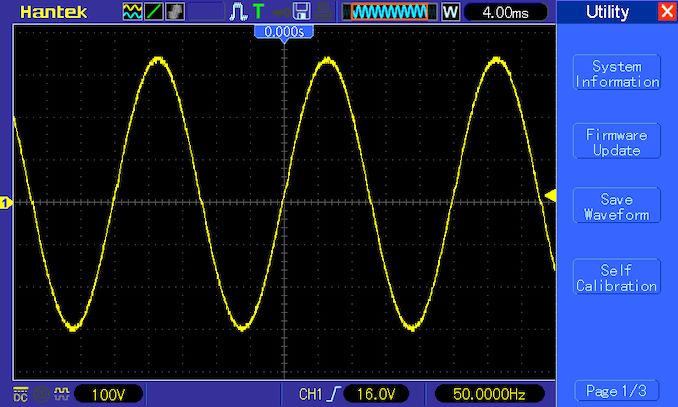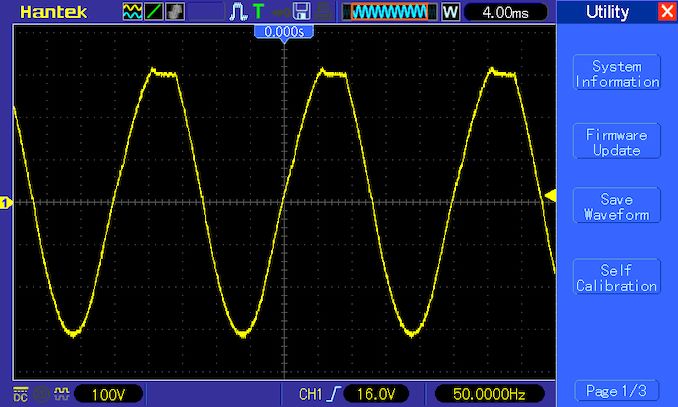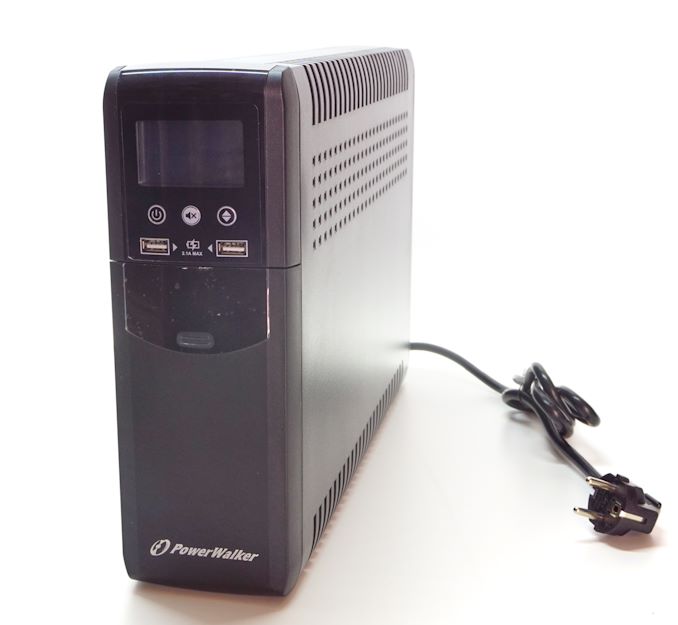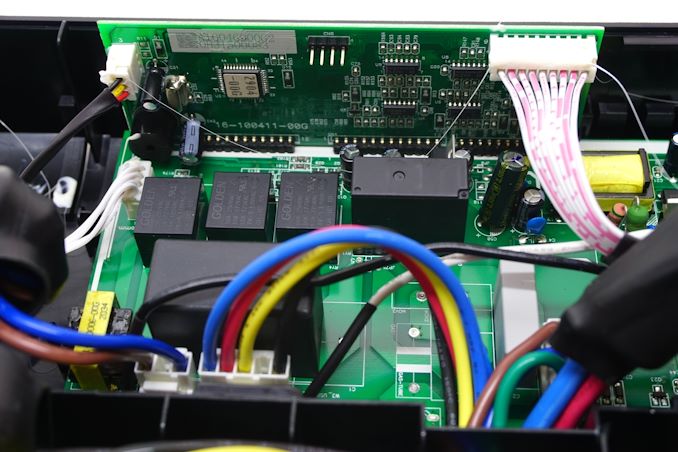The PowerWalker VI 1500 CSW UPS Review: Trying For True Sinewave on a Budget
by E. Fylladitakis on April 13, 2022 8:00 AM EST- Posted in
- Cases/Cooling/PSUs
- UPS
- PowerWalker
- BlueWalker
- 1500VA
Testing
Putting the PowerWalker VI 1500 CSW to the test, the basic electrical figures of the UPS are acceptable, with the unit delivering the performance it promises. When it operates on battery power, the voltage output is exactly 224 V RMS regardless of the load. There are minor frequency variations but these are exceptionally small. The transfer time is relatively high, yet not out of the manufacturer’s specifications. Though it also seems to significantly depend on the load, which should not be happening to this extent.
| UPS Load Performance | |||||
| 10% | 25% | 50% | 75% | 100% | |
| Voltage Output (Vrms) | 224 | 224 | 224 | 224 | 224 |
| Frequency (Hz) | 50.05 | 50 | 50 | 49.95 | 50 |
| Transfer Time (ms) | 6.1 | 7.6 | 7.8 | 7.6 | 8.9 |
The fan of the unit outputs 41.6 dB(A) once it is running. By UPS standards this is not a very high figure, but it's certainly not a very comfortable amount of noise, either. The downside here is that the PowerWalker VI 1500 CSW requires nearly 10 hours to fully charge its batteries once they are completely empty, which could be a problem with the unit installed in a living room or, worse, bedroom.
In our load testing, we've found that the battery runtime of the PowerWalker VI 1500 CSW is even better than advertised. These figures are achieved with its batteries fully charged and while they are new.
The PowerWalker VI 1500 CSW boasts true sinewave output, and our testing confirms this. Under load, our instruments showing a nearly-perfect sine wave with the unit running on battery power – but only while the load is low. Once the load reaches 50% (450 Watts) the deformation of the sine wave becomes apparent. It also becomes deformed abnormally, with only the positive peaks getting chopped, meaning that it is only one half of the circuitry failing to perform. At nearly 90% load (800 Watts) the waveform is nearly square, with both peaks heavily chopped, suggesting a massive number of harmonics. This will definitely not be healthy for any device that requires a pure sinewave input, such as APFC circuitry and AC motors.
Conclusion
The PowerWalker VI 1500 CSW is a UPS designed to combine a high output and true sinewave capability at a retail price affordable for most home consumers. At around €180, it currently retails for half of the price reputable manufacturers ask for their equally powerful true sinewave products, making it a very enticing deal.
The build quality of the PowerWalker VI 1500 CSW is better than one would expect from a product retailing at this price. Its parts are coming from reputable manufacturers and the unit is very well assembled. The design is dated but that is not inherently wrong – it just means the unit isn't geared to deliver the kind of top-of-the-line performance that more recent designs can provide.
When it comes to performance, the PowerWalker VI 1500 CSW performs, for the most part, according to its specifications. The trade-offs and issues become apparent when a closer look is taken, revealing that its electrical performance leaves a lot to be desired. The unit fails to maintain a true sinewave output when the load exceeds about 25% of its rated capacity, which could lead to serious issues if an application requires a true sinewave input. To be sure, for most home applications like modern PCs and TVs, this will not be a significant issue, as they take measures against harmonics and the expected load is usually but a fraction of the unit’s maximum output. However, if the unit needs to run at its maximum output or to drive loads that are very sensitive to harmonics, such as electric motors or older PCs, it could have damaging results to the equipment.
Ultimately, for users who are currently on the market for a UPS that is expected to mostly run at low loads, such as for safeguarding a single PC and its peripherals, the PowerWalker VI 1500 CSW is a fine choice. The UPS offers a clean enough electrical feed to meet the needs of a PC (or similarly switching power supply device), and it has the headroom to handle the stress if the power outage happens when the system is very heavily loads (e.g. while gaming). However, it is very clearly a device that was designed against engineering trade-offs to bring down costs for its target market. So, due to its inability to maintain a clean true sinewave output, we cannot recommend it for sensitive applications, and prospective users will want to be especially careful analyzing the sensitivity of their equipment to harmonics before purchasing it.
















107 Comments
View All Comments
kpp - Wednesday, April 20, 2022 - link
I had this 50w while on standby figure on 2 Mustek 2000VA that I used to own. I had a powermeter in the wall socket and was amazed when I noticed this. This was constant, not while charging.ranran - Friday, April 15, 2022 - link
I think this is a great idea/category, but I'm surprised you chose a European-market focused brand that is not really available here in the West.Perhaps you could consider doing reviews on the top two UPS companies, APC and Cyberpower? Expand this review to include comparisons with Cyberpower's CP1500PFCLCD and APC's BR1500MS true sinewave systems?
DanNeely - Friday, April 15, 2022 - link
If you have any contacts with those companies that could help convince them to send a sample to Greece I'm certain Ryan Smith and E. Fylladitakis would be grateful for your assistance. 🙄https://twitter.com/RyanSmithAT/status/15142159668...
nikitas589 - Friday, April 15, 2022 - link
Nice review. Yes, UPS reviews are definitely useful. And the noise test/commentary Ishould definitely be include for any UPS that may find its way to a home office /setting. One thing toe consider perhaps, speaking from experience, is the not all surge/power cut events register trigger a UPS (standby or interactive) to take over. For example I had a power cut trigger it while a milliseconds "on/off" type of thing did not and the PCs simply lost power. So you may want devise a couple of tests that are not instrument based or linear but more brutal ( pull the plug momentarily /tripping over the power cable for example, switch power on off, vary the timings, etc ) that are closer to what may happen to some of us. Still, UPS reviews: nice keep them coming..:-)mode_13h - Tuesday, April 19, 2022 - link
> I had a power cut trigger it while a milliseconds "on/off" type of thing did not and the PCs simply lost power.I've never seen a UPS fail to intervene in a power event that resulted in a PC rebooting. I'm not saying it doesn't happen, but not with the APC UPS units that I've used at home and at work.
swizznowt - Friday, April 15, 2022 - link
0.6 power factor, line interactive, no isolation, no common mode/normal mode protection. It's an APC by another name. Junk!Samus - Monday, April 18, 2022 - link
Could you perhaps determine what the trickle\standby voltage of the battery charging circuit is? I've seen a few models of APC UPS's lately that seem to overcharge the batteries to 12.8-13.1v, dramatically shortening their lifespan. One set of batteries from an APC XS1000 were so swollen they had to be pryed out and the unit\batteries were only 3 years old!Samus - Monday, April 18, 2022 - link
Specifically, could you test the measured float voltage of the batteries in UPS reviews?NeatOman - Monday, April 18, 2022 - link
For funzies YEARS ago when li-ion battery banks first started to become available for about $250, i found one with a pure sine wave and used it as a battery for a cart in a warehouse with 20" monitor, laptop, and label printer.That worked fantastic, then i got another one for a business with super flaky power that went in and out and at times read 90v from the wall, and computers and printers would have issues working. This time not only did it work as a UPS but also a line conditioner, you see these on servers all the time (there not just power strips sometimes). Basically the wall would charge/power whatever it could and the inverter would always be the one sending the power as a true "uninterruptable" power supply. It would correct, say 90v or 130v to a very stable 120v at the cost of loosing a bit of efficiency and also act as a far better surge protector. Surge suppressor should be your minimum when protecting your equipment, it ensures you don't get over voltage or "dirty" power. Anywho, a li-ion powered ups should be the norm for spending $200. Not only does it have more power, also smaller, charges much faster (recovery times between outages). Specifically LiFePO4 (lithium iron) batteries would be best, about 2-3 times the duty cycle of li-ion and higher amperage (can be smaller/less capacity and still have enough power for devices).
Oxford Guy - Thursday, April 21, 2022 - link
‘should be the norm’As should product truthfulness, rather than claiming sine wave output when that begins to fail beyond 25% load. Sadly, humanity is full of falsehoods for ‘profit’.